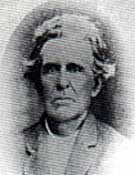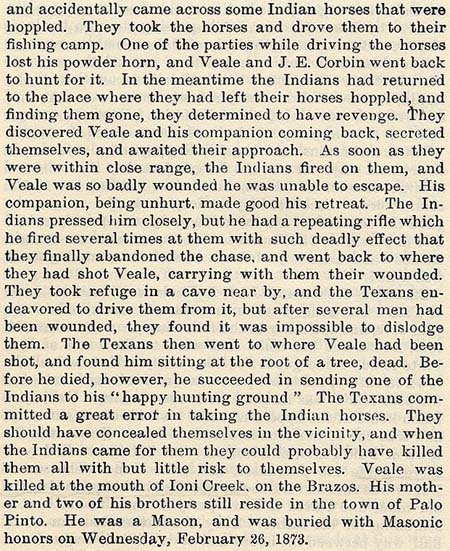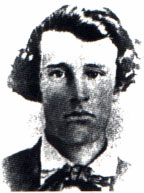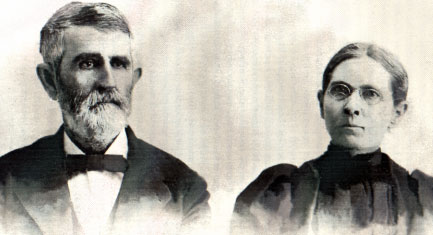Citizens of Palo Pinto Encounter Indians Near the Mouth of IoniThe author spent no little time, trouble, and money, and rode several hundred miles to compile, what is, no doubt, the true history and most complete account of the killing of Jesse Veale. After interviewing the very best of authorities, who convinced the author beyond a doubt, the present story was correct, he did not stop there, but made a special trip to Stephens County and to Oklahoma for the purpose of interviewing the widows of P. and Henry Veale, brothers of Jesse Veale to substantiate this report. The stories they related corroborated exactly our own version, reached after interviewing no less than thirty-five or forty surviving old settlers. We are going to take the liberty to say that we believe this to be by a broad margin the most detailed and accurate account of the killing of Jesse Veale and the fight that followed, that has ever been offered to the public. During February of 1873, P. Veale, Jesse Veale, and Jo E. Corbin, who lived at Palo Pinto went out to Ioni and camped near the mouth of Harris Branch, for the purpose of fishing, hunting bear, deer, turkey, and other wild game then found so abundantly in the brakes of the Brazos and its tributaries. February 21, the Veale brothers and Jo Corbin found some Indian saddles and stolen Indian horses, in the cedar brakes, while hunting near the Reasoner or Garland Bend. But somewhere up the river from the mouth of Ioni, Henry Veale lost either a blowing or powder horn. During the same day the Veale brothers and Jo Corbin also set some fishing hooks in the Brazos near the mouth of Ioni. Early in the morning of February 22 (Date taken from family Bible), P. and Henry Veale went back up the river to find, if possible, the lost horn. Jesse Veale and Jo Corbin, who were together, returned to the hooks set during the preceding day. The hooks were only about one and one-half miles away. So Jesse Veale and Jo Corbin were soon riding toward their camp. After they crossed Ioni, about one mile above its mouth, and rode upon the west bank, Jo Corbin, who was in the lead, said, "Jesse, we are surrounded by Indians, what shall we do?" Jesse replied, "Run out." About this time, Jesse Veale was wounded in the knee with an arrow, and since he was riding a nervous pony, saddled with one of the Indian saddles found during the preceding day, several citizens have surmised that his horse ran under a limb, forcing Jesse to dismount. It is possible, however, Veal's horse jumped so quickly, it ran from under its rider; or that Jesse said, "Fight it out." Instead of saying, "Run out," as Joe Corbin understood, as there were only about six or eight Indians. And it was about this time, Jesse Veale was wounded. An Indian attempted to get Jo Corbin's bridle reins, but when Corbin snapped his pistol, this Indian ducked away, and Corbin dashed on up the road toward the camp. Jesse Veale's pony, without a rider, followed closely behind. When Veale was last seen by his companion, he was on the ground, fighting desperately. Joe Corbin soon reached the mesquite flats, a short distance west of ioni, and southeast of the old Cam Williams Place. Here he stopped, and tied Jesse Veale's horse to a mesquite tree. Corbin then hurried on to the Mark Lynn Ranch home, near where the Watson ranch-house now stands.
|
||||||||
 |
 |
James A. Jowell |
Remnants of Jowell House |
It was after the noon-hour that P. and Henry Veale came back from up the river. When they crossed Ioni, and rode up the west bank, P. and Henry found Jesse sitting in a stooping posture, against the double-elm tree. The two brothers found Jesse before Mark Lynn and Jo Corbin were able to convey the news. The wagon was then brought from the camp, and in a short time, P. and Henry started slowly with Jesse to Palo Pinto. Jo Corbin also came to town. It is probable that he followed the wagon for a considerable distance, and then loped on ahead, before they reached their destination, for he was the first to bring the news to Palo Pinto. Since it was very late in the evening when the news arrived, and since it was not known where and in which direction the Indian trail would likely lead, it was agreed the volunteers from Palo Pinto should wait until the succeeding day to start after the Indians.
The next morning the citizens were in their saddles, and in a short time, strung out all the way from Palo Pinto to the Mouth of Ioni. Some went down Harris Branch, but, perhaps, a majority crossed over the top of Crawford Mountain. Lim Vaughan and Scott Warren numbered among the very first to pick up the trail where Jesse Veale was killed. The trail led across the creek to the east side of Ioni, and up into a little ravine to the southeast, where a small branch found its way from the flats, and where W.W. Price's dog, bayed the Indians, the day before. Here they found a dead Indian Jesse Veale had killed and Veale's missing hat was on the head of this savage. The streams of blood showed unmistakably, that at least two other Indians were also wounded. From the dead savage, the trail, which was blazed with the blood of the two wounded Indian warriors, led in a southeasterly direction, up the nearest tall mountain, and toward the cliffs. Lim Vaughan, Scott Warren and others followed the Indians' trail on up the west side of the mountain.
About this time, W.J. Hale and others, came down the Harris Branch, and then followed an old trail or roadway between the west side of Crawford Mountain, and the round hill that stands southeast of the mouth of Harris Branch. While they were still in the flats far below the retreating Indians, Lim Vaughan, Scott Warren and companions told Hale and the others the Indians had gone to the mountain. So they rode around to the north, and went up an old trail through the little canyon to the top of the tableland, where they soon joined others that had crossed over the crest of Crawford Mountain. They then scouted along the cliff while Lim Vaughan, Scott Warren and others followed the Indian trail on the west side. Shortly afterward, and before any savages were discovered, the Indians shot Al Bennet in the hip, about the time he stepped across a crevice on the top of the tall cliff. That, of course, was sufficient warning the Indians had been found. Then shortly after Al Bennett was wounded, some of the citizens saw the Indians passing around a rock under the bluff and it was about this time several shots were fired. The Indians were retreating toward a cave or crevice, that made a natural barrier and fortification. When the Indians were at or near this place Ben Slaughter, a negro, or "Buffalo soldier," as he was called by Indians, looked over the cliff, but no guns fired, so Jim Warren then stepped over to the cliff to see if Indians could be seen, and the savages shot him in the jaw. W.K. Bell helped carry Jim Warren away. The Indians were now surrounded, and with several citizens above and below, their escape seemed impossible. They were kept in this cave during the remaining part of the day. Al Bennett, Jim Warren, and his brother, Scott Warren, their father Armenus Warren, Jerry Hart, Lim Vaughan, W.J. Hale, Isom Wilder, W.K. Bell, Wm. Hittson, Geo. Kisinger, and Ben Slaughter, the negro, numbered among those who were on and under the cliff where the Indians were trapped. While the Indians were surrounded there was little firing. When night came, the citizens remained to keep the red men from escaping.
The next morning when P. and Henry Veale arrived, they were so infuriated over the death of their brother, P. and Henry took their guns and bowie knives, and made a dash into the cave where the Indians were concealed. Several other citizens followed for they did not want to see their friends torn to pieces.
Into the dark caverns of death they charged, where several wild demons were waiting. Such a daring exploit and dangerous adventure was seldom known in the history of the Southwest. Everybody breathlessly awaited the outcome, and the thundering of guns of both Indians and citizens. Forward the two brothers dashed to avenge the death of their brother. But when they entered, the Indians had accomplished the seemingly impossible; the warriors had slipped away and were gone.
Sometime during the same day, W.W. (Bud) Price saw where four Indians had recrossed the river, and were headed toward the "Shutins." A few months later, along the course they pursued, the body of a second dead Indian was found. Unquestionably this deceased warrior had been wounded by Jesse Veale, or the citizens during the brief fighting among the cliffs and crags of Crawford Mountain. According to reports, only two Indians finally reached the reservation. So after all, the Indians paid dearly for their dastardly deed.
The dead Indian, found across the creek about two hundred yards from Jesse Veale, was moved to Palo Pinto and after remaining at the old log jail for two or three days, the citizens carried his body to the hill north of Palo Pinto. Dr. C.B. Rains, however, saved the Indian's skull, and it was reported that sometime later a stranger, perhaps, from the reservation in Oklahoma, came to Palo Pinto and made inquiries about the Indians that were killed. When he was shown this particular skull, according to reports, he said, "Alas, poor Iris, I knew him well." The mission of this stranger was never fully known, and he disappeared as mysteriously as he came.
Near the body of the dead Indian, Lim Vaughan found the Indian's bow and this weapon was placed in a hall closet at the home of Mr. and Mrs. H.G. Taylor, where it remained for a long time. Jesse Veale was buried in the Upper Graveyard, about one and one-fourth miles southwest of Palo Pinto. He was the last person killed by Indians in Palo Pinto County; furthermore was the third Indian victim to be buried in the Upper Graveyard, and the seventh laid to rest in the two Palo Pinto cemeteries.
Note: Before writing this section, the author personally interviewed: W.W. (Bud) Price, mentioned above, and located, an pointed out to the author the stump of the old tree against which Jesse Veale was leaning when first found. Also interviewed: Jodie Corbin, a nephew of Joe Corbin, and a brother-in-law of Jesse Veale; Mrs. P. and Henry Veale, sisters-in-law of Jesse Veale: Milton Veale, a cousin; W.J. Hale, mentioned above; Dick Gordon, who worked on the Lynn ranch a few months after Jesse Veale was killed; Jack Hittson, who later owned the Lynn ranch, now known as the Watson ranch, and for some time had in his employ Jim Warren, who was wounded during the fighting. Jack Hittson said that Jim Warren several times visited the cave where the Indians were concealed, and often related the story. Also interviewed; E.K. and P.J. Taylor; Mrs. Jerry Hart, whose husband was in the fight; Mrs. Jane Bevers; Mrs. H.G. Taylor, at whose home Lim Vaughan left the Indian bow; W.B. Slaughter; Mrs. Armenus Warren, mother of Jim Warren who was wounded; John Warren, a brother of Jim Warren; and several others who were living in Palo Pinto County at the time.
Further Ref.: The family Bible that gave the date of Jesse Veale's death; the Minutes of the Old Settlers Ass. of Palo Pinto Co., for 1897; personal reminiscences of Henry Belding, printed in the Mineral Wells Index, during 1910; Biography of W.K. Bell, in the Cattle Industry of Texas; and Wilbarger's Indian Depredations in Texas.
The above story is from the book, The West Texas Frontier, by Joseph Carroll McConnell.
In his book, Indian Depredations in Texas, J.W. Wilbarger includes a short version of the death of Jesse Veale, which is printed below.


Home | Table of Contents | Forts | Road Trip Maps | Blood Trail Maps | Links | PX and Library | Contact Us | Mail Bag | Search | Intro | Upcoming Events | Reader's Road Trips Fort Tours Systems - Founded by Rick Steed |

